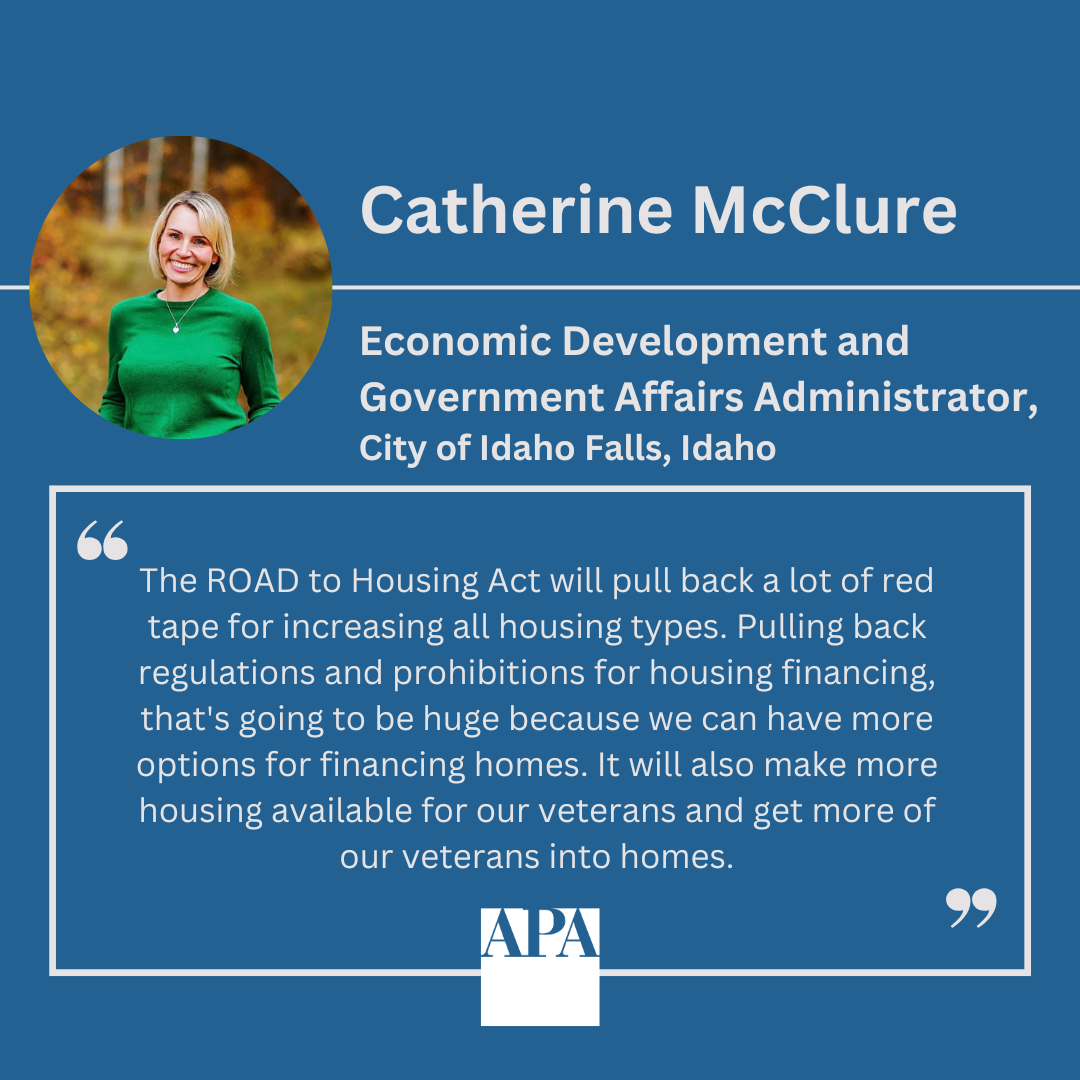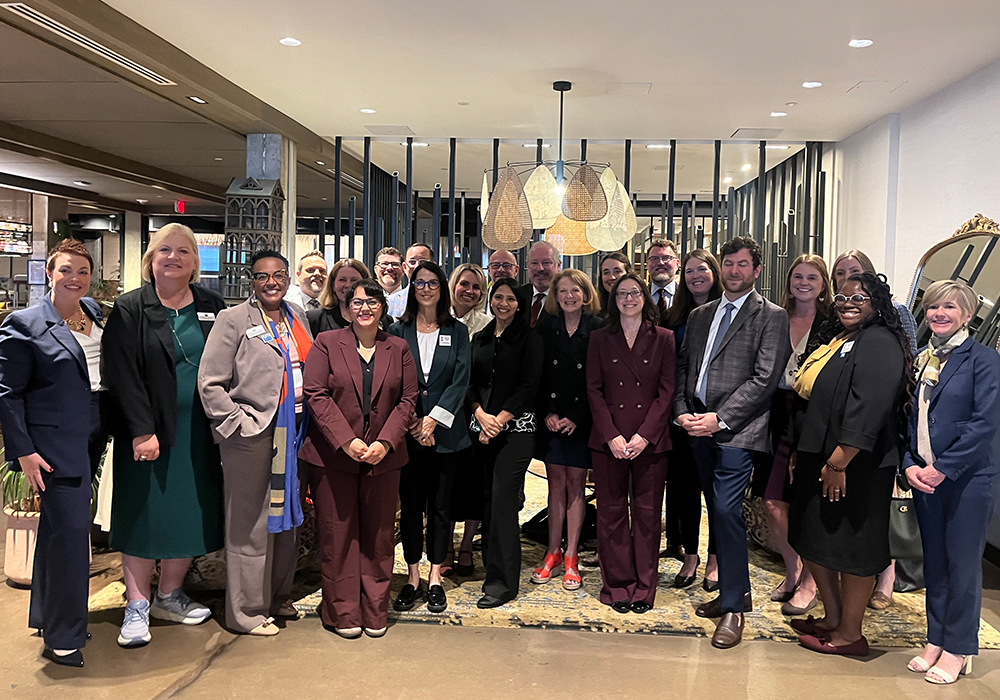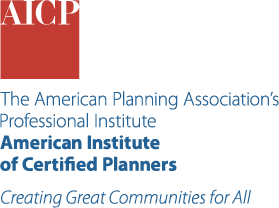Advocacy In Action
Idaho Population Boom Spurs Demand for Housing Action
Idaho planning advocate Catherine McClure takes to Capitol Hill to ensure federal support for housing meets a growing population's needs.

Increasing the housing supply has become a top national issue, and lawmakers at all levels are working toward solutions. Planners have long been at the forefront of housing and zoning reform efforts to increase housing supply in communities nationwide. Bipartisan support is growing in Congress, including the recent passing of the ROAD to Housing Act of 2025 in the Senate.
Planners Advocate Housing Reforms on Capitol Hill
Planning advocates got to take their insights on housing and what they have been seeing in their communities to Capitol Hill. Through meeting with their elected officials, they made it known that planners are ready to lead the way on reforms to create more missing middle housing.
APA Public Affairs Program Manager Brenna Donegan sat down with Catherine McClure, Economic Development and Government Affairs Administrator of Idaho Falls, Idaho, to discuss the housing challenges the city is facing. From population booms to combating NIMBY attitudes, McClure shared why Congress should support local reforms to increase housing in small and mid-sized cities throughout the state.
This interview has been edited for length and clarity.

BRENNA DONEGAN: What are the housing challenges your community is facing?
CATHERINE MCCLURE: When I was growing up, the community was just under 40,000 people. Now, we're just shy of 75,000, and the general population in the county is over 100,000. In just the last five years, since COVID-19, many people have traveled to Idaho Falls. They were social distancing with their families, and we've seen a lot of relocations from the West Coast into Idaho Falls. It is common to see out-of-state license plates, and our housing market has gone crazy as a reflection of that.
DONEGAN: Planners often look at infrastructure and housing as interconnected challenges. What is your perspective on how they fit together?
MCCLURE: We are really focusing on infill housing. We're looking at utilizing the infrastructure that already exists and focusing on those vacant lots that have not been developed. That is where we are putting multifamily, missing middle, and even single-family homes. Rather than allowing the city to sprawl, we're trying to encourage that gentle density because that best fits the community needs of Idaho Falls.
It's more helpful if people can live, work, and play in a walkable center rather than being 10 miles out and having to extend utilities outside of the city core. That's how we're attempting to manage that growth. It's a challenge, though, because property rights in the free market are strong in Idaho, as they should be. That's one of the core values of Idaho.
DONEGAN: You mentioned missing middle housing. Why is that a tactic for trying to boost housing supply, and what are some of the benefits you are seeing?
MCCLURE: We have found that more attainable housing can be developed with missing middle multifamily housing developments, whether it's apartments, townhomes, or condos. Idaho Falls has seen tremendous growth in multifamily housing, and it has changed what neighborhoods look like. It's meeting the need as we have folks that are moving into Idaho Falls to work remotely because of the amazing outdoor recreation and proximity to national parks. What we're finding is it's more affordable for young working professionals and families, since the current average single-family home is $468,000. When I originally bought my house 20 years ago, it was $73,000. The house is on the market right now for $350,000. It's crazy.
This is offering a more affordable option with amenities. Sometimes, if our Parks and Recreation Department can't support that population growth and demand, people are able to find it in their own multifamily housing, such as with pickleball and tennis courts, and pools. That's a win for the community to have private infrastructure support.
DONEGAN: How have planners and community housing champions responded to pushbacks and NIMBY attitudes in the community?
MCCLURE: We counter with data and numbers; the facts really speak for themselves. In Idaho Falls, multifamily housing is at 95 percent, according to our most recent market survey. Our homeowner agencies and our builders want to say Idaho Falls is still a single-family housing community, as it can be core to Idaho values. However, the market speaks, and it says that multifamily is very popular, which is fascinating.
I myself just sold a single-family home and moved into a multifamily housing unit. It's been really amazing to be in a townhome where I'm not mowing lawns or pushing snow. It's also been interesting to be on the other side, as people are complaining about people in multifamily at council meetings. There are a lot of negative assumptions made about people who are in townhomes. There's a lot of families and good people, so it's been a challenge to hear that criticism when you know the people that are in these housing options are just good people. It's just interesting for the community to shift and change through these growing pains.
DONEGAN: How has Idaho Falls been able to build so much? What recent reform efforts were in place to allow for quick building action?
MCCLURE: The city council passed an accessory dwelling unit ordinance in 2022, so that helped to bring in some of that gentle density for folks to be able to expand offerings on their own properties. We also did our 10-year comprehensive plan, where we held neighborhood meetings so that stakeholders could come in and help guide the conversation around future development. We were then able to put in comprehensive planning-led zoning reforms that matched what would work best for those neighborhoods. I also think we just have a very smart and nimble staff that, as building permits come through, it's a very hands-on process to help people work through the system.
It hasn't been perfect. But I think it has been really smart planning where the growth makes sense, and then also identifying those infill places and getting them zoned appropriately.
DONEGAN: What is one thing you hope federally elected officials can do to support planning to increase housing supply?

Catherine McClure (center) and other planning advocates in Washington, DC
MCCLURE: I think just [to understand] how important the decisions are and how the legislation actually really does impact local communities. The ROAD to Housing Act will pull back a lot of red tape for increasing all housing types. Pulling back regulations and prohibitions for modular housing financing that's going to be huge because we can have more options for financing for that prefabricated home. It also will make more housing available for our veterans and get more of our veterans into homes.
I'm glad to see some of the regulations with zoning that were passed earlier being pulled back a little bit to make sure that local municipalities have more flexibility to determine their own zoning regulations.
It's not a one-stop shop. We can't just say, "This works in these large metro areas," or "This works in these handfuls of rural areas," and paint it with all the same broad brush stroke. It is encouraging to see that there's more flexibility for local municipalities, but also keeping some guardrails because everyone deserves to live in safe, affordable housing.
Planning Advocacy Opportunities
PLANNERS' ADVOCACY NETWORK
Become a member of the Planners' Advocacy Network to stay up to date on federal action impacting the planning profession and receive opportunities on how you can get involved in advocacy opportunities.
Top image: iStock / Getty Images Plus - DenisTangneyJr
About the Author


